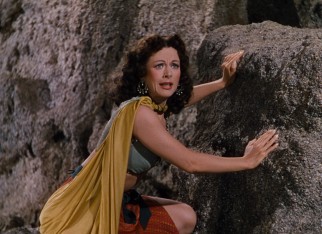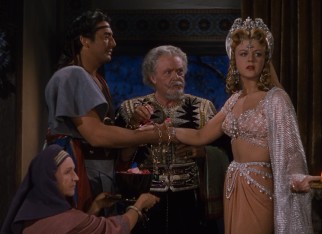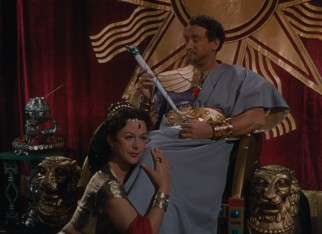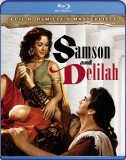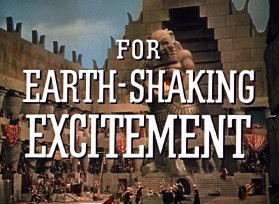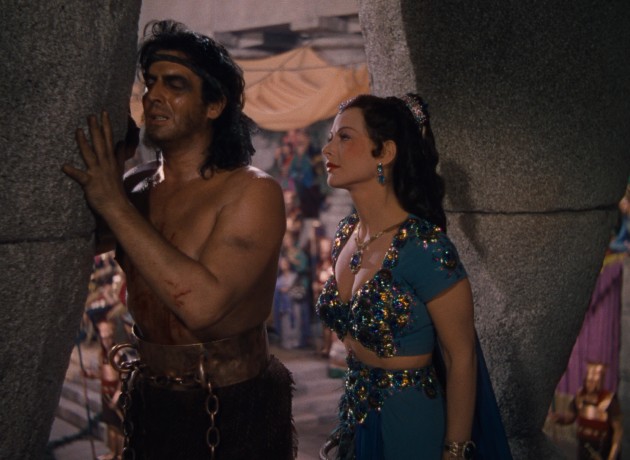Samson and Delilah Blu-ray Review
 |
Samson and Delilah
Theatrical Release: December 21, 1949 / Running Time: 134 Minutes / Rating: Not Rated Director: Cecil B. DeMille / Writers: Jesse L. Lasky Jr., Frederick M. Frank (screenplay); Harold Lamb, Vladimir Jabotinsky (original treatments) Cast: Hedy Lamarr (Delilah), Victor Mature (Samson), George Sanders (The Saran of Gaza), Angela Lansbury (Semadar), Henry Wilcoxon (Prince Ahtur), Olive Deering (Miriam), Fay Holden (Hazeleponit), Julia Faye (Hisham), Russ Tamblyn (Saul), William Farnum (Tubal), Lane Chandler (Teresh), Moroni Olsen (Targil), Francis J. McDonald (Storyteller), William Davis (Garmiskar), John Miljan (Lesh Lakish), Arthur Q. Bryan (Fat Philistine), Laura Elliot (Spectator), Victor Varconi (Lord of Ashdod), John Parrish (Lord of Gath), Frank Wilcox (Lord of Ekron), Russell Hicks (Lord of Ashkelon), Boyd Davis (First Priest of Dagon), Fritz Leiber (Lord Sharif), Mike Mazurki (Leader of Philistine Soldiers), Davison Clark (Merchant Prince), George Reeves (Wounded Messenger), Pedro de Cordoba (Bar Simon), Frank Reicher (Village Barber), Colin Tapley (Prince) |
Buy Samson and Delilah from Amazon.com: Blu-ray • DVD • Instant Video
Samson and Delilah hits Blu-ray on Tuesday, a year after finally making its DVD debut from Paramount Home Entertainment. Its long absence from 5-inch disc and subsequent lack of a concurrent Blu-ray option last March are puzzles that may never be solved. Attributed to four screenwriters and three chapters from the Book of Judges, Samson and Delilah tells the story of an unusually strong man and the woman whose largely unrequited love of him led to betrayal. A thousand years before the birth of Christ, Samson (Victor Mature) of the Dan tribe lives by his own rules. Instead of returning the love of sweet local woman Miriam (Olive Deering), Samson rides over to Timnah ask for the hand of a blonde Philistine named Semadar (Angela Lansbury). Military governor Ahtur (Henry Wilcoxon) has eyes for the same flaxen-haired maiden, so a rebuffed Samson takes a chariot with Semadar's brunette younger sister Delilah (Hedy Lamarr).
In the wild, Samson demonstrates his remarkable strength by wrestling a lion to death using nothing but his bare hands. Delilah is impressed, but the show of force, followed by a comparable defeat of a tall, hairy warrior, prompts the Saran of Gaza (George Sanders) to grant a request of Samson, which he uses to land the hand of Semadar. At the wedding ceremony, Samson bets thirty Philistines a garment for or from each that they cannot solve his riddle. The scorned Delilah gets involved and the wager winds up resulting in death and heightened hostilities.
Samson, who is proclaimed "the lion of Dan", cannot be tamed, no matter how great the opposition. He shows up the Philistine army with merely the jawbone of an ass, adding to his legend before he goes missing. As the Philistines try to devise a plan to capture this Dannite threat, Delilah volunteers to use her charms to seduce Samson and discover the secret of his power.
Like most of DeMille's efforts (save for, arguably, The Ten Commandments), Samson and Delilah is not considered a great film. It is, however, considered a significant one, as a major attraction of its time and a demonstration of mid-20th Century cinematic ambition. It's interesting how DeMille's notion of an epic is a far cry from ours. Today, the word "epic" triggers expectations of hordes of costumed extras, expansive locales, technical marvels, and a long runtime. Samson gives us little of all that, the director relying more on his titular leads striking theatrical, lobby card-ready, romantic poses at the center of the narrow Academy Ratio frame.
Yes, Samson was a Technicolor production at a time when that was still somewhat of a novelty largely reserved for musicals and westerns. Arriving ten years after Gone with the Wind and The Wizard of Oz took bold strides, though, this film doesn't do all that much to advance the medium. Much of Samson relies on static conversations conducted on small, artificial sets. Even upon release, this film drew more technical than dramatic notice. Its five Academy Award nominations all recognized technical aspects. The two Oscars that it won -- Best Art Direction-Set Decoration and Best Costume Design, both separating color films from black & white ones -- came in the categories most willing to overlook storytelling deficiencies. Samson isn't poor in that department, anyway, just not as riveting as it could be coming from scriptures in what many people consider to be the most important book in the world. This tale boils down to a star-crossed romance set against a conflict not made terribly palpable.
There are a number of creative choices you can question along the way. For instance, Samson is supposed to have this supernatural strength, yet Victor Mature has a typical broadness to him; perhaps that is more believable than the athlete's physique a modern production would require of an actor, but it certainly doesn't convey Samson's power. Similarly raising eyebrows is the casting of Angela Lansbury and Hedy Lamarr as sisters. Twelve years Lamarr's junior, Lansbury plays the elder sister, which you kind of accept because Lansbury has always had a matronly air (by 1962, she was playing the mother of a man three years younger than her). Still, it is odd that the beautiful Lamarr is an afterthought and concession in the presence of Lansbury, who fetches such exciting, exotic gifts as gauze.
Doubts of "epic" classification are removed in the big finale, as a disabled Samson is brought to public forum and ridiculed by little people. The sequence plays like a circus act, especially given the playful musical accompaniment supplied by Victor Young's Oscar-nominated score. If this near-climax feels undignified for the subject matter, it at least might have helped prepare DeMille for The Greatest Show on Earth, the 1952 drama that would win the Oscar for Best Picture, an honor it is today considered unworthy of. Broadening his scope to cover more of the Old Testament, DeMille would create a more satisfying religious epic in The Ten Commandments, the biggest hit of its time (greatly surpassing Samson, which was the runaway hit of '49) and still one of the most enduring thanks to annual television airings.
Exactly fifty-two weeks after making its long overdue debut on DVD, Samson and Delilah hits Blu-ray on Tuesday, timed to the Easter season with which it has long been associated. Like the DVD, the Blu-ray preserves the film's four-minute opening overture and two minutes of exit music, which brings it to a not so epic 134-minute runtime.
VIDEO and AUDIO This Blu-ray clearly emanates from the same costly 4K-scanned digital restoration used for last year's DVD. Measuring 1.37:1 (the precise Academy Ratio of the day) and revealing just a touch more width than the DVD, the 1.33:1 transfer is just about perfect, boasting a clean, vibrant, and consistent element. The picture looked soft on some Hedy Lamarr close-ups (probably out of generosity to the 35-year-old Austrian-American leading lady), but otherwise was as sharp and detailed as any '40s movie in 1080p. The film's monaural soundtrack is presented in Dolby TrueHD 2.0. While the recordings are dated, they are nonetheless intelligible and clear enough at all times. Blu-ray adds a Portuguese dub and subtitles to the French and Spanish ones carried over from DVD. English and English SDH subtitles are also included, ensuring no viewer has trouble following the film.
BONUS FEATURES, MENUS, PACKAGING and DESIGN Paramount's Blu-ray offers a slight upgrade over last year's DVD in the bonus features department, by including an HD theatrical trailer for Samson and Delilah (2:04). It comes from a rerelease (probably 1959) and is preceded by a modern Paramount logo, One wishes there was more to see alongside this rare catalog title Paramount has held on to. Or hear, even; IMDb's trivia page's reveals that the film was treated to a Lux Radio Theater broadcast in 1951 with Mature and Lamarr reprising their title roles. That'd be a no-brainer on a Criterion Collection disc. The release's simplicity extends to the menu and packaging. The former offers a static, silent screen adapted from the cover art, while the latter gives neither an insert nor a slipcover to the standard blue eco-friendly keepcase. The Blu-ray does not resume playback, but it does allow you to set bookmarks on the film.
CLOSING THOUGHTS After taking forever to turn up on DVD, Samson and Delilah arrives on Blu-ray just one year later, which raises questions about the need for such a delay. Nonetheless, classic films are revisited so infrequently these days that this release commands more attention and excitement than it would have years ago. This Cecil B. DeMille drama is reasonably engaging and technically noteworthy. Age makes this a classic more than quality, but it has enough of the latter to generate a bit more than historical interest. The Blu-ray's presentation offers obvious gains over 2013's DVD, with the film looking and sounding better than ever. The minimal supply of extras, a single reissue trailer, leaves plenty to be desired, but clearly, this is the best physical media edition this film will get for the foreseeable future. It's not a movie you'd purchase multiple times, but Blu-ray-collecting fans of the film who passed on the DVD should appreciate this, especially after an inevitable price cut. Support this site when you buy Samson and Delilah now from Amazon.com:
|
Related Reviews:
DVDizzy.com | DVD and Blu-ray Reviews | New and Upcoming DVD & Blu-ray Schedule | Upcoming Cover Art | Search This Site
Directed by Cecil B. DeMille: The Ten Commandments | New to Blu-ray: The Hunger Games: Catching Fire • The Grandmaster
George Sanders: The Ghost and Mrs. Muir • Rebecca • The Jungle Book • In Search of the Castaways
Angela Lansbury: Bedknobs and Broomsticks • Beauty and the Beast • Mr. Popper's Penguins • The Last Unicorn
Classics on Blu-ray: Sunset Blvd. • It's a Wonderful Life • From Here to Eternity • Lawrence of Arabia • I Married a Witch • Oliver!
The Last Temptation of Christ • Salome • America America • The Miracle Maker • The 3 Wise Men
Costume Design & Production Design Oscar Winners: Doctor Zhivago • The Great Gatsby • Titanic • Chicago • Alice in Wonderland (2010)

